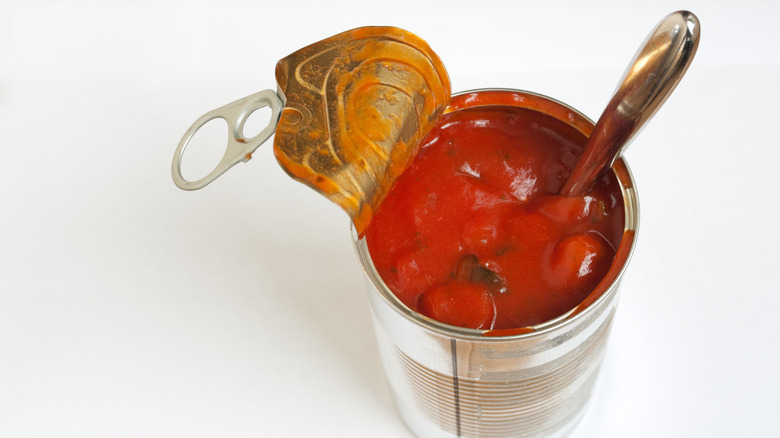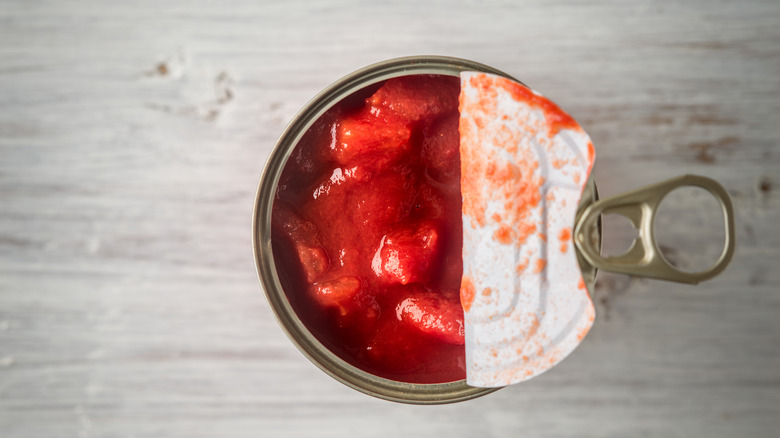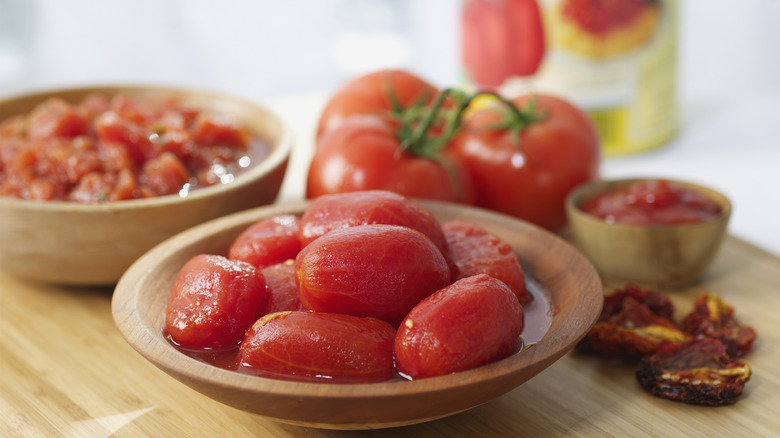The Quickest Way To Tell If San Marzano Tomatoes Are The Real Deal
San Marzano tomatoes are prized among home cooks and professional chefs alike. The canned plum-type tomatoes, often used for pizza and pasta sauces, feature a distinct flavor that makes the perfect base for many dishes. The detail that sets these specialty tomatoes apart is that they're exclusively grown in Agro Sarnese-Nocerino, a low-lying region of Italy. The tomatoes feature low acidity, sweetness, and a concentrated taste.
Many are willing to pay a premium to get their hands on a can of San Marzanos which, compared to other canned tomatoes, feature a pretty high price point. But the unfortunate reality is that, well, most San Marzano tomatoes on sale in the United States are not, in fact, San Marzano tomatoes. According to Taste, the president of Consorzio San Marzano — the organization that certifies the tomatoes — estimated in 2011 that as many as 95% of San Marzano tomatoes on the U.S. market are not the real thing. It's not clear how much that estimate may have changed in the years since, but the statistic is still buzzed about to this day. So how exactly can you spot a fake can of San Marzano tomatoes?
For starters, make sure that your San Marzano tomatoes are canned and are packaged whole, not diced. You will also want to make sure that your can has a DOP label as well as a Consorzio San Marzano certification number on the bottom of the can.
Why it can be so hard to spot a fake
Why, exactly, is the San Marzano market flooded with fraudulent tomatoes? For one, they are a highly desired product. But beyond this, there can be confusion in the United States regarding the certification of San Marzano tomatoes. The only marker of legitimate San Marzano tomatoes is the DOP label, which is short for Denominazione d'Origine Protetta, or Protected Designation of Origin. This label is meant to distinguish products of controlled Italian origins, similar to DOC labels that regulate Italian wine.
Even so, this classification is specific to Italy, and there is no regulation of DOP labeling in the United States. This means that some companies may add a false DOP label to their cans after the products are imported to the U.S. This can make it particularly difficult to spot a fake.
However, ensuring your tomato can has a DOP label and a Consorzio San Marzano seal, as well as a Consorzio certification number on the bottom is a good start. Even with all those factors, it could still be a fake — but checking for them is the closest you can get to a solid bet. Additionally, it is important to note that San Marzano tomatoes are not sold diced, with skin on, or uncanned. So if those products are labeled as San Marzano, they are not the real thing.
What makes a San Marzano so special
But what exactly makes San Marzano tomatoes so striking? Well, it starts with the soil. Agro Sarnese-Nocerino, where the tomatoes are grown, is near Mount Vesuvius. This region's volcanic soil is rich in potassium and phosphorous. This soil is believed to have an impact on the taste of San Marzano tomatoes, similar to how the terroir of a region impacts the taste of wine. And San Marzanos are different from most other tomatoes.
They have firmer walls and fewer seed pockets than many other varieties of tomatoes. They also have a lower moisture content, which is part of why they're so well-suited for sauces. All of these differences make San Marzano tomatoes the perfect choice for many dishes. And you will no doubt want to do your best to ensure that you are getting the real deal when you make your selection at the grocery store. This difference between San Marzano tomatoes and other varieties is unquestionable if you've ever had the real thing.


